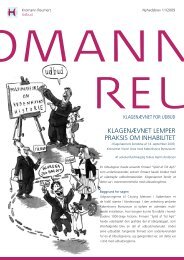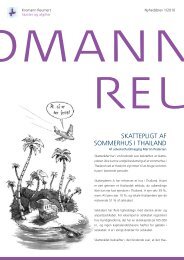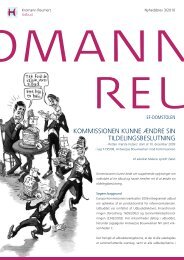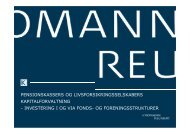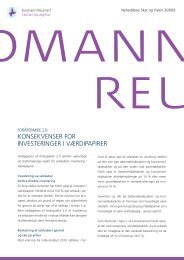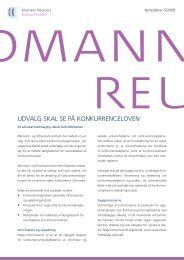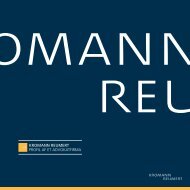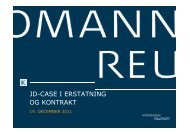OFFSHORE WIND ENERGY Kromann reumert leads the way
OFFSHORE WIND ENERGY Kromann reumert leads the way
OFFSHORE WIND ENERGY Kromann reumert leads the way
Create successful ePaper yourself
Turn your PDF publications into a flip-book with our unique Google optimized e-Paper software.
The future of green energy<br />
EU member states have agreed that by 2020, 20% of all<br />
Can renewable energy meet<br />
our requirements?<br />
New renewable energy capacity in EU in 2009<br />
(incl. de-commissioned capacity)<br />
EU energy consumption must come from renewable energy<br />
Many question whe<strong>the</strong>r existing renewable energy sources<br />
sources – this means that <strong>the</strong> share of energy generation<br />
based on renewable sources must rise from <strong>the</strong> 2005 level<br />
can meet our collective energy requirements. According<br />
to data collected by Deutsches Zentrum für Luft- und<br />
10,000<br />
10,163<br />
of 8.5% to 20% by 2020.<br />
Many member states are lagging behind in reaching <strong>the</strong>ir<br />
Raumfahrt in 2007, any of <strong>the</strong> existing renewable energy<br />
sources on <strong>the</strong>ir own could fulfil our primary global energy<br />
needs if exploited to <strong>the</strong>ir full potential, see figure on <strong>the</strong><br />
8000<br />
NEW CAPACITY<br />
DE-COMMISSIONED CAPACITY<br />
individual goals. Because of this, it is expected that <strong>the</strong>re<br />
will be many more opportunities to invest in green energy in<br />
<strong>the</strong>se countries in <strong>the</strong> coming years, as member states will<br />
opposite page.<br />
However, exploiting <strong>the</strong> full potential of <strong>the</strong>se resources<br />
6000<br />
6,630<br />
step up investments to catch up within <strong>the</strong> deadline.<br />
In 2008 and 2009 <strong>the</strong> installation of new renewable energy<br />
requires fur<strong>the</strong>r massive investments in renewable<br />
energy as well as continued technological developments<br />
to improve efficiency and reduce capacity costs. Also,<br />
4000<br />
4,200<br />
capacity in Europe exceeded <strong>the</strong> installation of new fossile<br />
fueled capacity.<br />
additional investments will be needed in <strong>the</strong> distribution<br />
grid so as to overcome <strong>the</strong> inexpediencies created by <strong>the</strong><br />
2000<br />
2,406<br />
As shown in <strong>the</strong> figure on <strong>the</strong> opposite page, this<br />
regional peak production from most of <strong>the</strong> renewable<br />
energy generating facilities through <strong>the</strong> creation of larger<br />
573<br />
581<br />
442<br />
439<br />
338<br />
covers a variety of energy sources, of which wind energy<br />
and solar (PV) power are currently <strong>the</strong> largest contributors.<br />
electricity pools. This is a challenge which, in <strong>the</strong> long run,<br />
could also be addressed through increased differentiation<br />
of different types of renewable energy sources (different<br />
peak periods to ensure a stable base load) as well as through<br />
0<br />
-2,000<br />
115<br />
404<br />
0<br />
472<br />
39<br />
24<br />
1,393<br />
166<br />
new energy storage solutions.<br />
-4,000<br />
3,200<br />
<strong>WIND</strong> NATURAL GAS PV COAL FUEL OIL BIOMASS WASTE NUCLEAR LARGE HYDRO<br />
EWEA 2010<br />
4 5



